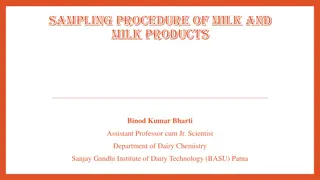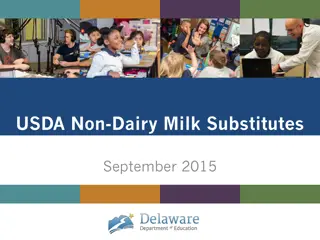Insights into Milk Composition and Processing
Worldwide, milk is collected from various animals such as cows, goats, sheep, yaks, and water buffalo. The composition of milk includes water, lactose, butterfat, protein, and minerals, each playing a vital role in its nutritional value. The butterfat content determines the richness of dairy products, with different types of milk having varying levels of butterfat. After the milk is adjusted for fat levels, it undergoes pasteurization to eliminate pathogens. Ultra-high-temperature pasteurization (UHT) further sterilizes milk, allowing UHT dairy products to remain unrefrigerated until opened.
Download Presentation

Please find below an Image/Link to download the presentation.
The content on the website is provided AS IS for your information and personal use only. It may not be sold, licensed, or shared on other websites without obtaining consent from the author.If you encounter any issues during the download, it is possible that the publisher has removed the file from their server.
You are allowed to download the files provided on this website for personal or commercial use, subject to the condition that they are used lawfully. All files are the property of their respective owners.
The content on the website is provided AS IS for your information and personal use only. It may not be sold, licensed, or shared on other websites without obtaining consent from the author.
E N D
Presentation Transcript
Check TPT and PDF. This is saved from a repaired file and may not have all the changes you made in 2016-17
Worldwide, milk is collected from animals such as: Cows Goats Sheep Yaks Water buffalo However the US Dairy industry focuses on the milk produced by millions of cows.
Water (87.7%) Human beings, as well as animals require more water than any other nutrient. Lactose (4.7%) Lactose is the main carbohydrate in milk, also called sugar though it is not sweet enough to taste. It can cause digestive problems for people who are lactose intolerant.
Butterfat (3.7%) Butterfat is the fat portion of the milk. The more butterfat in the milk, the richer it tastes. Protein (3.2%) Milk proteins are crucial for making cultured dairy products and cheese. Minerals (0.7%) Milk is an excellent source of minerals needed for growth such as calcium and phosphorus.
Aside from making milk taste rich, butterfat is the most coveted part of the milk. Dairy products are largely defined by the amount of butterfat they contain. Type of Milk Butterfat Content Minimum of 3.5 percent Whole Milk 2% milk (reduced fat) 1% milk (low fat) Skim milk (nonfat) 2 to 2.5 percent 1 to 1.5 percent Less than 0.5 percent
Once the fat levels in the milk are adjusted, the milk is pasteurized. The process of pasteurization heats the milk to specific length of time to kill pathogens. For instance, milk can be pasteurized by heating it to 161 F for 15 seconds or 275 F for 2 to 4 seconds.
Ultra Pasteurization Ultra high temperature (UHT) heats milk to 280 F for 2 to 6 seconds, and then it is sealed in sterilized containers. As a results, UHT dairy products do not need refrigeration before being opened (but always after)
Homogenization Homogenization permanently and evenly distributes the butterfat in the milk. The homogenization process will turn the milk a bright white color. Milk that has not been homogenized has a greenish tint and easily separates into a cream layer that floats to the top of a thin watery portion.
The process of removing water from milk causing the levels of proteins, sugars, and butterfat to increase. The three most common concentrated milk products are: Evaporated Milk Sweetened condensed milk Dried milk powder
This milk has had 60 percent of the water removed, and yields a thick, rich product It is sold canned.
This milk has had 60 percent of the water removed and a large amount of sugar added. It is thick, rich, and very sweet. Also sold canned and is commonly used in baked products.
This product is a skim milk that has had nearly all of the water removed resulting in a white powder that does not require refrigeration and has a long shelf life.
Butter represents the dairy product with the highest percentage of butterfat. Churning cream makes butter. Churning is another word for rapid mixing. During churning, lumps of butterfat emerge and begin to stick together to form larger and larger pieces of butter.
Eventually, a large mass of butter is produced along with a small amount of watery liquid. This watery liquid is referred to as buttermilk. Salt is added to butter to improve its shelf life. Unsalted butter does not have any added salt and has a short life.
Individually wrapped, one-pound pieces of butter typically called butter prints; packed 36 pounds to a case. This pack is popular with foodservice. Individually wrapped, quarter- pound sticks; packed four sticks to a box and 36 boxes to a case. This pack is commonly sold in grocery stores.
Individually portions, such as cardboard backed patties, foil wrapped chips and cups. Whipped butter is butter that has been mixed with a gas such as nitrogen. The added gas makes the butter soft and fluffy.
Cultured dairy products have been made for thousands of years and remain popular today. They are easily recognized for their sour taste and moderately thick texture. What separates fresh dairy products from cultured dairy products is the addition of friendly bacteria.
To make cultured dairy products: Pasteurization kills harmful bacteria. Next, specific strains of bacteria are added to the warm milk. As the bacteria reproduce, they consume the lactose and produce lactic acid making it less sweet and noticeably more acidic. The increase in acid also thickens the dairy product. Once it reaches the desired stage of thickness and acidity, it is refrigerated (cultures are still alive).
Once the cultured dairy product reaches the desired stage of thickness and acidity, it is refrigerated. The colder temperature stop bacterial growth, but does not kill the bacteria. In fact, the labels of many cultured dairy products indicate that the cultures are live.
Buttermilk Originally referred to the watery liquid that remained after churning butter. Now it is skim milk with strains of bacteria added to make the milk more acidic and to thicken the liquid. Buttermilk is used in baked products and salad dressings.
Yogurt Yogurt is a centuries old product. Made by adding several strains of bacteria to warm milk. Once the bacteria have changed the flavor, texture and acidity level of the milk, it is often sweetened and flavored before sold. Adding thickeners such as gelatin or pectin to the yogurt produces some thick varieties of yogurt.
Sour Cream Is a common product in baked goods and is served as a condiment for savory dishes. Unlike buttermilk and yogurt, sour cream starts with a high-fat dairy product light cream. Finished sour cream must have a minimum butterfat content of 18 percent.
Bell Work With your face partner: List as many different types of cheeses as you can think of. Be prepared to share
Worldwide, there are literally thousands of varieties of cheese. Cheese varies dramatically in shape, color, and flavor.
What separates cheese from cultured dairy products is the amount of moisture in the finished product. Cheese has less moisture than milk. Reducing moisture levels means that the cheese is less likely to spoil. The more moisture removed from the cheese, the longer it will last. A very dry cheese can last for years without spoiling.
1. Every cheese begins as milk. 2. Fat level is adjusted by adding or removing fat from the milk. 3. Bacteria is added to the milk. Bacteria increases the acidity, changes the flavor, and thickens the milk. **Just like a cultured milk product
4. A small amount of coagulant (an ingredient that causes the milk to thicken dramatically) is added to the milk. Typical coagulant -rennet. Bacteria + rennet = Milk turns into a semisolid mass. 5. Thickened milk is cut into cubes that contain casein proteins (one of the two types of protein in milk) These are called curds.
6.Curds get drained, mixed and sometimes heated causing them to shrink. When they shrink, whey is expelled. Whey is the watery portion of the milk that contain the whey proteins (the 2nd milk protein). The more whey that is removed from the curds, the firmer the cheese will be. Salt can also be added to the curds to remove even more moisture. 7.The curds are then placed in a mold and pressed. With time, these curds knit together to form cheese.
Fresh Cheeses Soft Cheeses Medium Firm Cheeses Hard Cheeses Blue Cheese Stretched Cheeses Processed Cheese
Are high in moisture and barely aged Slightly sweet and milky flavored. Since they are high moisture, they spoil more easily than other cheeses (have a short shelf life) Examples: cream cheese, cottage cheese, ricotta
Have elastic or creamy textures When they are well aged, they can even become runny Examples: Brie, Camembert and lightly aged goat cheeses
Have a drier and firmer texture Have a longer shelf life Made with curds that are cut smaller, sometimes the curds are lightly cooked The curds are placed in a mold and pressed which removed the whey. Medium firm cheeses are aged for at least a month before being sold. Examples: Morbier, Monterey Jack, Fontina, Colby
The driest cheese and there for have very long shelf lives Curd is cut into small pieces, cooked at high temps, and firmly pressed into molds. Ages for months or even years. Sometimes referred to as grating cheeses Examples: Parmesan, Cheddar, Swiss, Manchego, Gruyere
The blue color in blue cheese is actually a type of edible mold. The mold that grows inside the cheese intensifies the flavor of the cheese. Not all blue cheeses are blue, the mold can have varying shades of green, grey and blue. Examples: Stilton, Gorgonzola, Maytag Blue and Danish Blue
Not many types, but the most popular category of cheese To make stretched cheeses, hot curds are repeatedly stretched to produce strands of cheese. Stretch cheeses are generally eaten with little aging and have an elastic, medium firm texture. Examples: mozzarella, string cheese and provolone
Vast quantities of processed cheese are eaten daily in America. Most famous member of this category? American cheese! Processed cheese begins with medium firm or hard cheeses that are grated and melted. As the cheese melts, it is mixed with an emulsifier, water and possibly additional fat. The resulting hot cheese paste is then rolled into singles, formed into blocks or squirted into jars.
Closure Look at the list of cheese you made at the beginning of class. With your face partner, go back through the list and determine what category each cheese belongs to. Write it next to the name.























